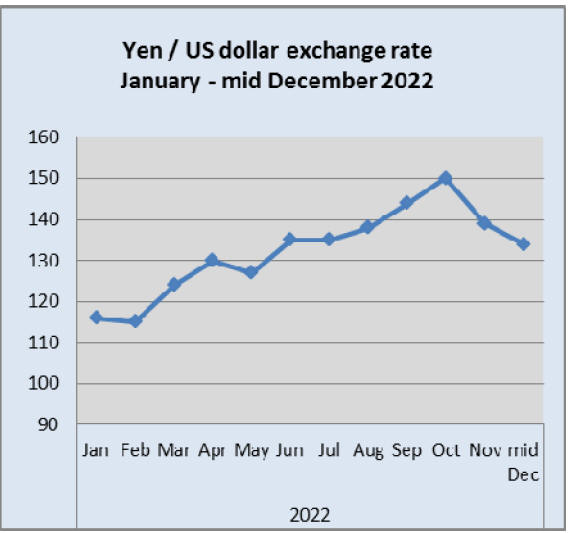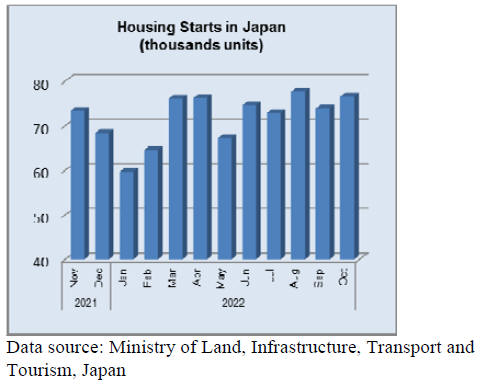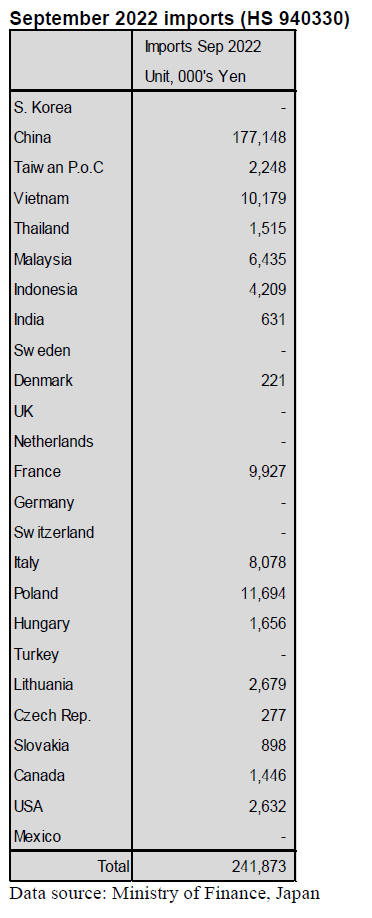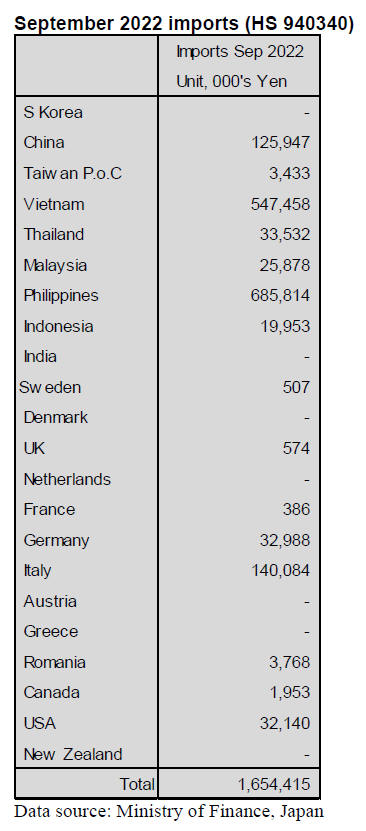Japan
Wood Products Prices
Dollar Exchange Rates of 12th
Dec
2022
Japan Yen 136.7
Reports From Japan
High level uncertainty for medium to long term
growth prospects
In December, sentiment among the major Japanese
manufacturers rose for the first time in four months and in
the service sector optimism was growing as companies
began to see signs of consumers spending again. But there
were concerns in both sectors that there is a high level
uncertainty for medium to long term prospects. This
uncertainty stems from the up and down recovery from the
pandemic in Japan, the slowdown in China which could
get worse as covid retrictions are eased and infections
spread and the risk of a global downturn.
Rising prices and weak consumer spending – slow growth anticipated
Kanako Tanaka and Fumiko Kuribayashi have
summarised the main findings of a recent Asahi Shimbun
survey of 100 major companies as follows:
-
More than half of leading companies believe the
economy has stalled or is slowly contracting
because of rising prices and sluggish consumer
spending.
-
46% of companies in the latest survey
viewed the
economy as flat, up by 9% from the previous
survey.
-
7% said the economy is slowly shrinking.
-
53% gave a pessimistic assessments of the
economy compared with 38% in the spring
survey.
-
The number of companies that feel the economy
is slowly expanding fell to 46 out of 100 from 59
in the previous survey.
-
No company assessed the economy as on a steady
growth path.
Asked to provide the main concerns for the
economy:
-
59 companies cited rising prices of crude oil
and
raw materials
-
34 companies said flagging consumer spending
was a big concern. This was more than double the
figure in the previous survey.
-
20 companies mentioned the weakened yen.
See:
https://www.asahi.com/ajw/articles/14785900
Rise in key indicator of capital spending
Private-sector machinery orders, excluding volatile ones
for ships and those from electric power companies,
increased a seasonally adjusted by 5.4% in October.
This was better than the 2.6% rise expected by economists
polled by Reuters. Compared with a year earlier core
orders, a highly volatile data series regarded as a leading
indicator of capital spending in the coming six to nine
months, rose.

Consumer sentiment weighed down by price increases
The latest consumer sentiment survey in November
showed that consumers were even less optimistic than in
the previous month. This follows three consecutive
months of declines. In assessing the survey officials say
consumer sentiment is being weighed down by recent
price increases for daily necessities. They also say an
increase in the number of coronavirus cases may also be a
factor. More than 60% of survey respondents said they
think prices will be at least 5% higher in twelve months.
On the basis of the survey the Cabinet Office revised
downward its assessment of consumer sentiment for the
second month, describing it as "weakening." That word
was used for the first time since October 2019.

Yen strengthens
US inflation figures for November showed that annualised
rates fell from 7.7% to 7.1%, the lowest level in almost a
year. Better than expected inflation numbers drove
expectations about the future path of US interest rate
hikes.
The US$/Yen exchange rate moved after the release of US
inflation data with the yen strengthening to around 134 to
the dollar, the strongest it has been all month.

Concerns raised on availability construction
workers
ResearchAndMarkets.com has released its ‘Japan
Construction Industry Report 2022’ which says demand is
expected to grow by 5.0% to reach around US$245 billion
in 2022. However, the report notes challenges from rising
material costs and inflation which have put pressure on the
construction sector. Additionally, the construction sector
has raised concerns on the availability of skilled labourers.
As the country deals with the shrinking workforce foreign
workers are expected to play a significant role over the
next three to four years in driving construction activities
and market growth in Japan.
See:
https://www.researchandmarkets.com/reports/5025237/japanconstruction-
market-growth-trends-covid#src-pos-3

Import update
Furniture imports
The weak yen, unprecedented inflation and the risng cost
of everyday necessities has undermined consumer
sentiment and the first to suffer are purchases of
discretionary items such as furniture. Since mid-year there
has been a downward trend in the value of furniture
imports mirroring traders’ assessment of consumer
demand.

September wooden office furniture imports
(HS940330)
For shippers of wooden office furniture, China, Poland,
Vietnam and Malaysia accounted for around 85% of
September exports to Japan. September shipments from
Malaysia were far above that in August.
Shipments from China were down slightly but despite this
China alone accounted for over 70% of wooden office
furniture shipmemts.
Compared to the previous month and to September 2021
the value of imports of wooden office furniture were
largely unchanged.

September 2022 kitchen furniture imports (HS 940340)
As was the case for most of 2022, four suppliers accounted
for most of the value of Japan’s imports of wooden
kitchen furniture.
The top four shippers are the Philippines and Vietnam
along with Italy and China. In September this year the
value of shipments from both the Philippines and Vietnam
were down from August but shippers in Italy and China
saw gains in September.
The value of September 2022 imports of kitchen office
furniture were over 30% up on September 2021 but
compared to August this year there was a drop of nearly
10%.

September wooden bedroom furniture imports (HS
940350)
September marked the third consecutive decline in the
value of Japan’s imports of wooden bedroom furniture
(HS940350).
Despite this September 2022 imports were around 40%
higher than in September 2021 and the weak yen exchange
rate may be part of the reason for the surge in the value of
imports. Compared to the value of August imports there
was a 6% decline in September.
In September this year the top suppliers of wooden
bedroom furniture were China, Vietnam, Malaysia and
Thailand. These four shippers accounted for over 90% of
the value of September shipments into Japan.
The value of imports of wooden bedroom furniture from
China were down about 10% in September, imports from
Vietnam were down slightly but imports from both
Malaysia and Thailaind rose month on month.

Trade news from the Japan Lumber Reports (JLR)
The Japan Lumber Reports (JLR), a subscription trade
journal published every two weeks in English, is
generously allowing the ITTO Tropical Timber Market
Report to reproduce news on the Japanese market
precisely as it appears in the JLR.
For the JLR report please see:
https://jfpj.jp/japan_lumber_reports/
Price hikes of adhesive
Several manufacturers which produce adhesive will raise
the prices in December in this year. Oshika Corporation
raises over 10% of the current prices on adhesive product
for industrial use and constructions. MGC Woodchem
Corporation raises 20 – 40 % up in next month. Those
price hikes would influence production costs of plywood
and laminated lumber.
Oshika’s price hike is the 4th times in this year
and MGC
Woodchem’s price hike is the 2nd times in this year.
Log auction fairs in Okayama prefecture
There was a domestic log fair held at Tsuyama Sogo
Mokuzai Ichiba in Tsuyama, Okayama prefecture. The
market was lively and active. 3m cypress log was 21,500
yen. This is a sign of recovery in log markets. There were
2,200 cbms of logs offered at the fair. 3m cypress log was
16,000 yen at the fair held on 16th, September. The prices
at this time are 1,500 yen higher than the previous fair
held on 28th, October. 4m cypress log is 19,000 yen from
14,000 yen.
There were enough cypress logs at the northern part of
Okayama prefecture stimulated by the wood shock. Then
the prices dropped by oversupply. The cypress logs at
lumber plants had enough logs. In other areas, there had
been damages by a typhoon and there was a shortage of
logs. The lumber plants had many inquiries and the prices
rose. Other reasons are that movement of lumber was good
and log quality is better harvested in colder temperature.
There was a competition of good quality log from forests
under private ownership on the same day at a different
place. There were 6,300 cbms logs for the competition.
37% of 6,300 cbms was cedar logs and 60% was cypress
logs. 3m cypress log was 30,000 – 40,000 yen and 4m
cedar log was 35,000 – 40,000 yen. These are over 5,000
yen higher than previous time. 6m cedar log was 30,000 –
35,000 yen.
Log markets in Tohoku region
There is an atmosphere of an increase in log prices at
domestic log markets in Tohoku region. In Miyagi
prefecture, 4m cedar log is 14,000 – 15,000 yen, delivered
per cbm and this is 1,000 yen higher than previous month.
Cedar logs were unpopular until recently and the prices of
cedar logs kept falling.
However, it changed. 3m cedar log for posts is around
16,000 yen in Miyagi prefecture. 3.65m cedar log is
around 17,500 yen in Akita prefecture.
Movement of larch logs stays same and also the prices are
the same. 4m larch log for lumber is around 25,000 yen.
There is no recovery of demand for plywood. Hardwood
logs and red pine logs are not enough volume at the
markets because the temperatures were high in this year
and there might be damages on the logs. Oak and chestnut
logs cost high and oak log was 70,000 yen at the market.
A model house made of lumber
Aqurahome Corporation opened a model house which is a
five-story-building and wooden building. This is the first
model house with timber framework method in Japan. The
model house is not a base-isolated structure and it is an
aseismatic structure without special metal tools.
This model house is a prototype of the company and it
does not take a lot of cost to build. Size of posts is 210 mm
squares and of beams is 210 x 310.
Three gypsum plasterboards are used at the 1st floor and
are fire resistance for two hours. 60 mm LVL are used at
the 2nd floor to 5th floor. This LVL is resistant to fire for
an hour. The company will apply the certification for this.
There will be stores on the 1st floor, rental offices on the
2nd floor, rental houses on the 3rd floor and an owner’s
house on the 4th and 5th floors. Aqurahome will set up an
office on the 2nd floor after the show house finishes.
It will reduce Co2 generated during constructions of
wooden buildings. About 105 ton of Co2 will be reduced
and this is half volume of Co2 which is generated during
reinforced-concrete constructions and steel constructions.
Carbon storage is 84 ton converted into Co2.
Plywood
Movement of domestic softwood plywood started
improving since early November but not strong enough to
push the prices up yet so that plywood mills continue
production curtailment.
In October, movement of Chinese imported plywood
slowed down after some of Chinese plywood failed to
meet JAS standard then some domestic mill had fire,
which stopped the production. Both incidents did not help
stopping weak market. Chinese plywood was
supplemental supply for domestic supply and it was
expected to decline once domestic supply satisfies the
market. Fire was one of Seihoku group’s plant and other
Seihoku plants covered the supply shortage.
With increase of non-residential buildings and delayed
construction, the plywood demand is recovering so that the
manufacturers’ plywood inventory is expected to decline
at the end of November but usual demand pickup in
December seems remote now so the manufacturers plan to
continue production curtailment.
Prices of imported South Sea hardwood plywood
continues stay up high. With increased inventory and
advancing depreciation of the yen, the importers are
unable to place new orders. Some completed receiving all
the order files.
Normally the market prices decline when orders decrease
to promote sales but South Sea manufacturers adamantly
stick to high export prices as fixed cost increases when the
production declines. Then it is rainy season now and log
supply gets tight so there is no reason that the suppliers
need to reduce the sales prices.
Export prices of standard plywood of 24 mm 3x6 are
US$1,500 per cbm C&F. 3.7 mm is $1,250 and 5.2 mm is
US$1,200. With exchange rate of 140 yen dollar, 2.4 mm
and 3.7 mm may meet market prices in Japan. The prices
in Japan are 970 yen per sheet on 2.5 mm, 1,300 yen on 4
mm and 1,450 yen on 5.5 mm. 12 mm 3x6 concrete
forming panel for coating prices are US$850 per cbm C&F
and structural panel prices are US$780.
The weak yen
An effect of the weak yen for imported plywood markets
is not as big as lumber markets. A number of new
purchases for plywood is declining like a lumber’s
situation but the future’s price of imported South Sea
plywood in South East Asia are very high and the futures
price of lumber in Canada or Europe are not. Japanese
buyers concern about the import cost due to the weak yen
so they hesitate to buy future plywood.
Volume of imported plywood in September, 2022 was
201,117 cbms, 15% less than September, 2021. It was for
the first time in 16 months to decrease. There were delays
for loading plywood in the past and the plywood arrived
Japan with a large volume until August so some trading
companies did not purchase new plywood. This is why the
volume of imported plywood in September decreased. The
decrease will continue until December in this year and the
inventory volume will be around 170,000 cbms.
It is hard for the trading companies to buy new plywood
because the futures price of plywood in overseas are high
and also the weak yen will be the problem for them. In
Japan, imported South Sea plywood for coated plywood
for concrete forming of 3 x 6 of 12mm costs 2,400 yen,
delivered per sheet. Forming plywood with 3 x 6 of 12mm
costs 2,200 yen, delivered per sheet. Structural plywood
with 3 x 6 of 12mm costs 2,300 yen, delivered per sheet.
In overseas, the futures price of coated plywood for
concrete forming costs US$850, C&F per cbm. Uncoated
forming plywood with 3 x 6 of 12mm costs $760, C&F
per cbm. Structural plywood costs US$780, C&F per cbm.
Import cost would be 2,600 yen, FOB per sheet for coated
plywood for concrete forming, 2,330 yen, FOB per sheet
for uncoated forming plywood and 2,390 yen, FOB per
sheet for structural plywood. The import costs are
calculated with exchange rate of 147 yen per dollar.
To trade in futures, the trading companies need to think
carefully about lowering US$100 per cbm in overseas
export prices or raising 200 yen per sheet in Japan.
However, it is a rainy season in South Asia and it is
difficult to request sellers to lower the prices. Also, there
are too much inventory of plywood in Japan so it is unable
to raise the market prices.
There are two opinions about coated plywood for concrete
forming and uncoated forming plywood. These two kinds
of plywood have less inventory than standard plywood.
One of the opinions is that it will be able to raise 200 yen
up if supply and demand are balanced. Another opinion is
to buy plywood in Japan until a shortage occurs at
domestic markets. For standard plywood, it will take much
time to balance supply and demand due to overstocking. |